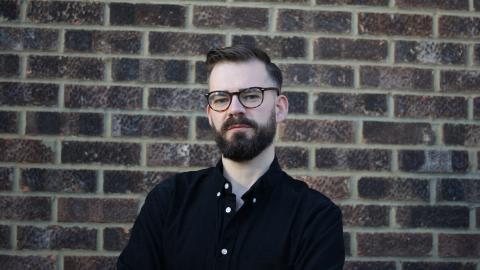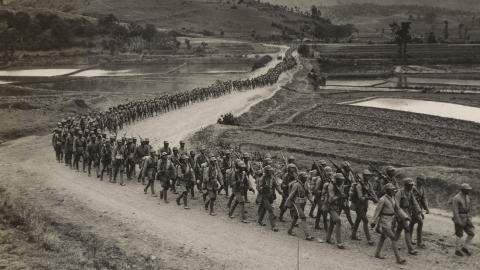After the liberation of Auschwitz-Birkenau,
'They didn't want us to come back, they didn't want to have to settle their accounts with us and look us in the eye,'
January 27 1945
'A ghastly sight arose before our eyes: a vast number of barracks. People lay in bunks inside many of them. They were skeletons clad in skin, with vacant gazes.'
Those were the words of Alexander Vorontso, a camera operator with the Red Army who was part of a film crew sent to document the horrors of the most infamous Nazi death camp of them all – Auschwitz-Birkenau.
Auschwitz was liberated by the soldiers of the 100th Infantry Division and the 60th Army of the 1st Ukrainian Front on the 27th of January 1945. What greeted them when they entered the gates of the largest of Auschwitz’s three main camps, Birkenau, was a vision of hell. In the barracks Vorontso’s crew would later document, the soldiers found bunk beds crammed full of barely alive human skeletons crawling with lice. Rats scampered across floors encrusted with excrement. The dead lay amongst the living. Outside the barracks, withered, hollow-cheeked inmates shuffled amongst the corpses. The stench of death hung heavy in the air.
At first, the inmates didn’t even acknowledge the soldiers’ presence. One Soviet soldier, Georgii Elisavetskii, would later recall how he tried to explain that he and his comrades were there to liberate the prisoners. After telling them they were free in several languages, he eventually told them they were free in Yiddish, and on hearing the language so despised of their Nazi tormentors, those who were able rushed to their liberators and fell at their feet, kissing their greatcoats and boots. For many, this was a moment they never thought would come.
Those left behind were mostly sick or dying. The vast majority of prisoners – some 58,000 – had been rounded up and marched out of the camp in an infamous ‘death march’ that saw a quarter of them die in the freezing winter temperatures on the long journey to concentration camps in Germany and Austria. Of the inmates still left in the camp, most suffered from a multitude of health problems such as malnutrition and diarrhoea. Typhus was rife throughout the camp. Of the 7,500 prisoners the Russians found across Auschwitz’s three main camps and various sub-camps, hundreds would die after liberation despite the soldier’s efforts to sanitise the camp and provide the prisoners with better food and accommodation.
Some were able to leave the camp, stepping out of the gates in a state of bewilderment, unable to quite believe this wasn’t yet another cruel trick by the devils who had made their lives a living hell for so long. Others, some 4,500 in total, were in no fit state to leave. To look after them, a temporary field hospital was set up and the patients were treated by Russian army doctors and nurses. Representatives of the Red Cross would swell their ranks from February onwards. At first, the death rate among the sick was high as a combination of malnutrition and typhus took their toll on the prisoners’ ravaged bodies. Eventually, after a permanent hospital was established in the brick-built barracks of Auschwitz I, death rates steadily dropped until by July, most former prisoners were well enough to leave the hospital.
When former inmates did manage to leave, their thoughts naturally turned towards home. Unfortunately, for many of Auschwitz’s former prisoners, that meant making their way – usually on foot - through territory overrun by Soviet soldiers brutalized by the war. As the survivors fanned out from the camp, the majority heading for various towns and cities across Eastern Europe, many were robbed of what meagre possessions and rations they had managed to acquire. Worse, women faced the very real threat of being raped by Red Army soldiers who were frequently drunk and indifferent to the suffering the women had already endured.
'They didn't want us to come back, they didn't want to have to settle their accounts with us and look us in the eye,'
Those who did manage to make it home in the Soviet-occupied territories did not receive the welcome they had imagined. Many found their old homes occupied by Russians or locals who cared little for the property rights of people who had no way of proving they were the rightful owners. Business owners were equally given short shrift. Even former friends could not be relied upon.
This was the experience of Walter Fried and his father who survived Auschwitz and made their way back to their hometown of Topolcany in Czechoslovakia. Before being sent to the camp, Walter’s father had stashed a parcel containing diamonds, gold and money with an old family friend who promised to look after it until his return. However, when Walter’s father approached his friend and asked for the parcel, the friend said all that had been left with him was a bundle of clothes.
'They didn't want us to come back, they didn't want to have to settle their accounts with us and look us in the eye,' Walter later said of the betrayal. 'Our best friends from before became our worst enemies.'
The stories of liberated Jews returning home to a frosty reception was repeated time and again. Many found that their old communities had been completely destroyed; their families, friends and neighbours long since dispatched in the network of extermination and slave labour camps the Nazis had established across Poland and beyond. With nothing left of their old lives, many looked instead to the newly established land of Israel. Some would also find new homes in Western Europe and the United States.
While the survivors of the camp tried to make the best of their situation, for some of those who had been responsible for running Auschwitz, a day of reckoning was fast approaching. Remarkably, only about 15% of the people who worked at Auschwitz were prosecuted for their crimes – a mere 789 men and women. Most prominent of all was the camp’s longest-running commandant, Rudolph Hoss. Hoss went on trial before the Supreme National Tribunal in Warsaw on the 11th of March 1947. He was found guilty and, fittingly, hanged near to the site of Crematorium I at Auschwitz on the 2nd of April. The gallows used can be seen there to this day.
A further trial took place in Warsaw in November 1947, where twenty three of the forty defendants were sentenced to death, with the rest receiving lengthy prison sentences. For many former Auschwitz employees, however, justice did not come for them and they slipped back into civilian life, many going to their graves never having to atone for their sins. One of the last people to be tried for their involvement in the Holocaust was Oscar Groning, a bookkeeper at Auschwitz who was sentenced to four years imprisonment in 2015. He never spent a day in prison thanks to his lawyers launching a series of appeals. Groning died in hospital in 2018 at the age of ninety-six.
UNESCO added Auschwitz to its list of World Heritage Sites in 1979
As for the camp itself, the Polish government recognized it as a state memorial in 1947. By that stage, many of the wooden barracks from Birkenau had been removed from the site and relocated to Warsaw where they were used as accommodation and workshops for workers rebuilding the city. Today, only a small number of the barracks remain on site.
A small museum opened in Auschwitz I in 1955 displaying some of the items the Soviets had discovered on liberating the camp such as piles of suitcases, clothes, human hair, mugshots of the prisoners and canisters of Zyklon B. The museum’s directors were all former inmates up until 1990.
UNESCO added Auschwitz to its list of World Heritage Sites in 1979, two years after West German Chancellor Helmut Schmidt made a historic visit to the camp - the first of his office to do so. 1979 also saw Pope John Paul II hold a public mass outside Birkenau’s main entrance, where he called the site ‘the Golgotha of our age’. This reference to the crucifixion of Christ, along with the establishment of a convent just outside the camp and an increasing number of crosses springing up to commemorate Christian Poles who had mainly died in Auschwitz I, led to Jewish groups criticizing what they saw as the ‘Christianisation’ of Auschwitz. The convent was eventually relocated after the intervention of John Paul II. All but one of the crosses were taken down.
Over the years, interest in the former concentration camp grew and grew. After the fall of the communist regime in 1989, tourist figures rose dramatically as a newly democratic Poland flung open its doors to the world. From a trickle of visitors in the 1950s, Auschwitz now attracts over two million tourists, scholars and pilgrims a year.
In 2005, the United General Assembly declared the 27th of January to be International Holocaust Memorial Day. The date was chosen because that was the day troops from the Red Army first set foot in the most infamous Nazi concentration camp of them all. Auschwitz was once a place of unimaginable suffering and death. Today, it teems with life as people from all over the world come to remember the 1.1 million souls who lost their lives there.
















